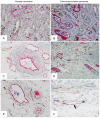Neoangiogenesis of gastric submucosa-invasive adenocarcinoma
- PMID: 30128004
- PMCID: PMC6096252
- DOI: 10.3892/ol.2018.9116
Neoangiogenesis of gastric submucosa-invasive adenocarcinoma
Abstract
Early gastric cancer may be defined as mucosal or submucosal invasive carcinoma, and exhibits a good prognosis: 90% of patients survive >10 years. Early gastric cancer infrequently exhibits lymph node metastasis, although submucosal invasion, the presence of vascular invasion and/or lymphatic permeation are independent risk factors for lymph node metastasis in early gastric cancer. The analysis of tumor lymphangiogenesis and angiogenesis are important to determine the extent of invasive progression and metastasis in patients. Previously, the presence of vessels expressing the D2-40 antibody and the factor-VIII protein has been identified immunohistochemically. The vessels that are immunoreactive for D2-40 and factor-VIII are morphologically similar to lymphatic vessels or small-size veins, also termed venules. In the present study, the association between tumor invasion and neoangiogenesis in early gastric cancer was examined. The D2-40/factor-VIII double-stained vessel (DSV) density was analyzed, in addition to lymphatic and blood vessel (vein and artery) density, using 46 submucosa-invasive and 50 mucosal carcinomas, and 20 non-neoplastic gastric tissues. The lymphatic density and DSV density of submucosa beneath the carcinoma and submucosa of the surrounding region in submucosa-invasive carcinoma were significantly increased (P<0.001) in comparison with those in mucosal carcinoma or non-neoplastic gastric tissue. No significant difference was observed in blood vessel density between non-neoplastic gastric, mucosal carcinoma and submucosa-invasive carcinoma tissues other than that of mucosa. The present study suggests the potential for the presence of D2-40/factor-VIII DSV and the importance of this vessel for neoangiogenesis in early gastric cancer.
Keywords: D2-40; and factor-VIII; early gastric cancer; progression.
Figures





References
-
- Kidokoro T. Frequency of resection, metastasis, and five year survival rate of early gastric carcinoma in a surgical clinic: Early Gastric Cancer. Japanese Scientific Press; 1971. pp. 43–49.
-
- Lauwers GY, Carneiro F, Graham DY, Curado MP, Franceschi S, Montgomery E, Tatematsu M, Hattori T. Gastric carcinoma. In: Bosman FT, Carneiro F, Hruban RH, Theise ND, editors. WHO Classification of Tumours of the Digestive System. 4th edition. World Health Organization; Switzerland: 2010. pp. 48–58.
LinkOut - more resources
Full Text Sources
Other Literature Sources
